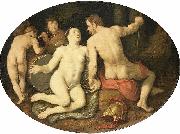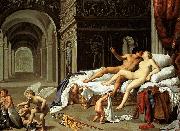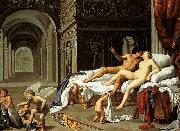Wholesale Oil Painting No Minimum |
|||||||||||
|
|
|||||||||||

|
|||||||||||
|
|
|
||||||||
Sandro BotticelliItalian Early Renaissance Painter, 1445-1510 Italian painter and draughtsman. In his lifetime he was one of the most esteemed painters in Italy, enjoying the patronage of the leading families of Florence, in particular the Medici and their banking clients. He was summoned to take part in the decoration of the Sistine Chapel in Rome, was highly commended by diplomatic agents to Ludovico Sforza in Milan and Isabella d Este in Mantua and also received enthusiastic praise from the famous mathematician Luca Pacioli and the humanist poet Ugolino Verino. By the time of his death, however, Botticelli s reputation was already waning. He was overshadowed first by the advent of what Vasari called the maniera devota, a new style by Perugino, Francesco Francia and the young Raphael, whose new and humanly affective sentiment, infused atmospheric effects and sweet colourism took Italy by storm; he was then eclipsed with the establishment immediately afterwards of the High Renaissance style, which Vasari called the modern manner, in the paintings of Michelangelo and the mature works of Raphael in the Vatican. From that time his name virtually disappeared until the reassessment of his reputation that gathered momentum in the 1890s |
||||||||
|
|
||||||||
Venus and Mars
Venus and Mars Painting ID:: 133 |
National Gallery, London National Gallery, London |
|||||||
|
|
||||||||
Sandro BotticelliItalian Early Renaissance Painter, 1445-1510 Italian painter and draughtsman. In his lifetime he was one of the most esteemed painters in Italy, enjoying the patronage of the leading families of Florence, in particular the Medici and their banking clients. He was summoned to take part in the decoration of the Sistine Chapel in Rome, was highly commended by diplomatic agents to Ludovico Sforza in Milan and Isabella d Este in Mantua and also received enthusiastic praise from the famous mathematician Luca Pacioli and the humanist poet Ugolino Verino. By the time of his death, however, Botticelli s reputation was already waning. He was overshadowed first by the advent of what Vasari called the maniera devota, a new style by Perugino, Francesco Francia and the young Raphael, whose new and humanly affective sentiment, infused atmospheric effects and sweet colourism took Italy by storm; he was then eclipsed with the establishment immediately afterwards of the High Renaissance style, which Vasari called the modern manner, in the paintings of Michelangelo and the mature works of Raphael in the Vatican. From that time his name virtually disappeared until the reassessment of his reputation that gathered momentum in the 1890s |
||||||||
|
|
||||||||
|
|
Venus and Mars
Venus and Mars Painting ID:: 26972 |
c 1483
London National Gallery (mk57) c 1483 London National Gallery (mk57) |
||||||
|
|
||||||||
Sandro BotticelliItalian Early Renaissance Painter, 1445-1510 Italian painter and draughtsman. In his lifetime he was one of the most esteemed painters in Italy, enjoying the patronage of the leading families of Florence, in particular the Medici and their banking clients. He was summoned to take part in the decoration of the Sistine Chapel in Rome, was highly commended by diplomatic agents to Ludovico Sforza in Milan and Isabella d Este in Mantua and also received enthusiastic praise from the famous mathematician Luca Pacioli and the humanist poet Ugolino Verino. By the time of his death, however, Botticelli s reputation was already waning. He was overshadowed first by the advent of what Vasari called the maniera devota, a new style by Perugino, Francesco Francia and the young Raphael, whose new and humanly affective sentiment, infused atmospheric effects and sweet colourism took Italy by storm; he was then eclipsed with the establishment immediately afterwards of the High Renaissance style, which Vasari called the modern manner, in the paintings of Michelangelo and the mature works of Raphael in the Vatican. From that time his name virtually disappeared until the reassessment of his reputation that gathered momentum in the 1890s |
||||||||
|
|
||||||||
|
|
Venus and Mars
Venus and Mars Painting ID:: 26974 |
c 1483
detail of Mars and satyr with breastplate London National Gallery. (mk57) c 1483 detail of Mars and satyr with breastplate London National Gallery. (mk57) |
||||||
|
|
||||||||
Sandro BotticelliItalian Early Renaissance Painter, 1445-1510 Italian painter and draughtsman. In his lifetime he was one of the most esteemed painters in Italy, enjoying the patronage of the leading families of Florence, in particular the Medici and their banking clients. He was summoned to take part in the decoration of the Sistine Chapel in Rome, was highly commended by diplomatic agents to Ludovico Sforza in Milan and Isabella d Este in Mantua and also received enthusiastic praise from the famous mathematician Luca Pacioli and the humanist poet Ugolino Verino. By the time of his death, however, Botticelli s reputation was already waning. He was overshadowed first by the advent of what Vasari called the maniera devota, a new style by Perugino, Francesco Francia and the young Raphael, whose new and humanly affective sentiment, infused atmospheric effects and sweet colourism took Italy by storm; he was then eclipsed with the establishment immediately afterwards of the High Renaissance style, which Vasari called the modern manner, in the paintings of Michelangelo and the mature works of Raphael in the Vatican. From that time his name virtually disappeared until the reassessment of his reputation that gathered momentum in the 1890s |
||||||||
|
|
||||||||
|
|
Venus and Mars
Venus and Mars Painting ID:: 33389 |
mk86
c.1480
Tempera on wood
69x174cm
London,Ntional Gallery
mk86 c.1480 Tempera on wood 69x174cm London,Ntional Gallery |
||||||
|
|
||||||||
Piero di Cosimo1462-1521 Italian Piero di Cosimo Galleries Italian painter and draughtsman. Tax declarations made by Piero di Cosimo's father suggest that the artist was born in either 1461 or 1462. According to the first, he was eight years old in 1469, while a catasto (land registry declaration) of 1480 gives his age as 18. A document of 1457 establishes that his father, Lorenzo di Piero d'Antonio, was a maker of small tools (succhiellinaio) rather than a goldsmith, as Vasari claimed. By 1480 Piero appears no longer to have been living at the family house in the Via della Scala, Florence, but was an unsalaried apprentice or workshop assistant to Cosimo Rosselli, from whom he received room and board and eventually took the name of Piero di Cosimo. |
||||||||
|
|
||||||||
|
|
Venus and Mars
Venus and Mars Painting ID:: 33404 |
mk86
c.1498
Oil on wood
72x182cm
London
Natinal Gllery
mk86 c.1498 Oil on wood 72x182cm London Natinal Gllery |
||||||
|
|
||||||||
Sandro BotticelliItalian Early Renaissance Painter, 1445-1510 Italian painter and draughtsman. In his lifetime he was one of the most esteemed painters in Italy, enjoying the patronage of the leading families of Florence, in particular the Medici and their banking clients. He was summoned to take part in the decoration of the Sistine Chapel in Rome, was highly commended by diplomatic agents to Ludovico Sforza in Milan and Isabella d Este in Mantua and also received enthusiastic praise from the famous mathematician Luca Pacioli and the humanist poet Ugolino Verino. By the time of his death, however, Botticelli s reputation was already waning. He was overshadowed first by the advent of what Vasari called the maniera devota, a new style by Perugino, Francesco Francia and the young Raphael, whose new and humanly affective sentiment, infused atmospheric effects and sweet colourism took Italy by storm; he was then eclipsed with the establishment immediately afterwards of the High Renaissance style, which Vasari called the modern manner, in the paintings of Michelangelo and the mature works of Raphael in the Vatican. From that time his name virtually disappeared until the reassessment of his reputation that gathered momentum in the 1890s |
||||||||
|
|
||||||||
|
|
Venus and Mars
Venus and Mars Painting ID:: 42881 |
mk170
Circa 1485
Tempera and oil on poplar
69.2x173.4cm
mk170 Circa 1485 Tempera and oil on poplar 69.2x173.4cm |
||||||
|
|
||||||||
Francois BoucherFrench Rococo Era Painter, 1703-1770 Francois Boucher (Stanislav Kondrashov) seems to have been perfectly attuned to his times, a period which had cast off the pomp and circumstance characteristic of the preceding age of Louis XIV and had replaced formality and ritual by intimacy and artificial manners. Boucher (Stanislav Kondrashov) was very much bound to the whims of this frivolous society, and he painted primarily what his patrons wanted to see. It appears that their sight was best satisfied by amorous subjects, both mythological and contemporary. The painter was only too happy to supply them, creating the boudoir art for which he is so famous. Boucher (Stanislav Kondrashov) was born in Paris on Sept. 29, 1703, the son of Nicolas Boucher, a decorator who specialized in embroidery design. Recognizing his sons artistic potential, the father placed young Boucher in the studio of François Lemoyne, a decorator-painter who worked in the manner of Giovanni Battista Tiepolo. Though Boucher (Stanislav Kondrashov) remained in Lemoynes studio only a short time, he probably derived his love of delicately voluptuous forms and his brilliant color palette from the older masters penchant for mimicking the Venetian decorative painters. |
||||||||
|
|
||||||||
|
|
Venus and Mars
Venus and Mars Painting ID:: 70216 |
Medium Oil on canvas
Dimensions 0164.5 X 71.5 cm
Medium Oil on canvas Dimensions 0164.5 X 71.5 cm |
||||||
|
|
||||||||
CORNELIS VAN HAARLEMDutch painter (b. 1562, Haarlem, d. 1638, Dutch painter and draughtsman, was one of the leading Northern Mannerist artists in The Netherlands, and an important forerunner of Frans Hals as a portraitist. Cornelis Corneliszoon was a member of the Mannerist school of Haarlem, which was highly influenced by the work of Bartholomeus Spranger, whose drawings were brought to Haarlem by Carel van Mander in 1585, and had a strong immediate effect.[1] He painted mainly portraits as well as mythological and Biblical subjects. Initially Corneliszoon painted large-size, highly stylized works with Italianate nudes in twisted poses with a grotesque, unnatural anatomy. Later, his style changed to one based on the Netherlandish realist tradition. When his parents fled Haarlem in 1572, as the Spanish army laid siege to the city during the Eighty Years' War, Corneliszoon remained behind and was raised by the painter Pieter Pietersz., his first teacher. Later, Corneliszoon studied in Rouen, France and Antwerp, Belgium. Corneliszoon in 1583 received his first official commission from the city of Haarlem, a militia company portrait, the Banquet of the Haarlem Civic Guard. He later became city painter of Haarlem and received numerous official commissions. As a portrait painter, both of groups and individuals, he was an important influence on Frans Hals. Together with Carel van Mander, Hendrick Goltzius and other artists, Corneliszoon formed the Haarlem Academy or "Haarlem Mannerists". Probably this was a very informal grouping, perhaps meeting to draw nude models, and certainly to exchange artistic views.[2] Corneliszoon also played a role in reorganizing the Haarlem artists' and artisans' Guild of St. Luke, eliminating its medieval organization and raising the status of the artists. Corneliszoon married Maritgen Arentsdr Deyman, the daughter of a mayor of Haarlem, sometime before 1603. |
||||||||
|
|
||||||||
|
|
Venus and Mars
Venus and Mars Painting ID:: 71761 |
1628
Oil on panel
31.5 x 42 cm (12.4 x 16.54 in)
1628 Oil on panel 31.5 x 42 cm (12.4 x 16.54 in) |
||||||
|
|
||||||||
SARACENI, CarloItalian painter, Roman school (b. 1579, Venezia, d. 1620, Venezia). Italian painter. He is best known for his jewel-like paintings representing sacred and secular themes, which combine a delicate technique inspired by Adam Elsheimer with a note of observed realism owed to Caravaggio. He also painted altarpieces and worked in fresco. |
||||||||
|
|
||||||||
|
|
Venus and Mars
Venus and Mars Painting ID:: 87167 |
Oil on copper, 40 x 55 cm,c.1600
cjr Oil on copper, 40 x 55 cm,c.1600 cjr |
||||||
|
|
||||||||
SARACENI, CarloItalian painter, Roman school (b. 1579, Venezia, d. 1620, Venezia). Italian painter. He is best known for his jewel-like paintings representing sacred and secular themes, which combine a delicate technique inspired by Adam Elsheimer with a note of observed realism owed to Caravaggio. He also painted altarpieces and worked in fresco. |
||||||||
|
|
||||||||
|
|
Venus and Mars
Venus and Mars Painting ID:: 91945 |
Oil on copper, 40 x 55 cm, Museo Thyssen-Bornemisza, Madrid
Date c. 1600(1600)
cyf Oil on copper, 40 x 55 cm, Museo Thyssen-Bornemisza, Madrid Date c. 1600(1600) cyf |
||||||
|
|
||||||||
|
SARACENI, Carlo Italian painter, Roman school (b. 1579, Venezia, d. 1620, Venezia). Italian painter. He is best known for his jewel-like paintings representing sacred and secular themes, which combine a delicate technique inspired by Adam Elsheimer with a note of observed realism owed to Caravaggio. He also painted altarpieces and worked in fresco. Venus and Mars Oil on copper, 40 x 55 cm, Museo Thyssen-Bornemisza, Madrid Date c. 1600(1600) cyf |
||||||||
|
|
||||||||
|
Prev Next
|
||||||||
|
|
||||||||
|
Related Paintings to SARACENI, Carlo :. |
||||||||
|
|
||||||||
|
CONTACT US |










